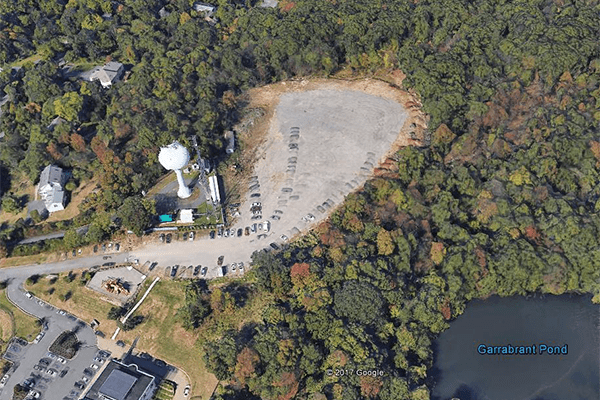|
RCBJ-Audible (Listen For Free)
|
Balloon Test Scheduled For Saturday Examines Visual Impact Of Proposed Building On Peak Of Mountainview Avenue
Staff Report
Hoping to chip away at the Town of Clarkstown’s concerns over the proposed construction of a 30,000 square-foot building on its property on a town road, the Islamic Center of Rockland (ICR) on Saturday is conducting a “viewshed” test to determine whether its proposed structure will disrupt prized vistas.
To make such a determination, ICR’s engineers will erect four red balloons on the corners of the building’s proposed footprint to determine the impact of the 32-foot structure situated at the highest point on Mountainview Avenue in Valley Cottage.
The test will run from 7 am to 4 pm, weather permitting.
Local residents opposing the project are asking people to share images of the balloons from different locations.
But an obstructed viewshed is only one – if not a more minor obstacle – for the ICR, which has been trying to build the addition and add 200 legal parking spaces for years. To begin, the applicant is up against a local law passed in 2016 that says certain permitted “non-residential uses in residential zones, including houses of worship, must be located on a state or county road. Mountainview Avenue, a winding, often treacherous road that spans from Route 59 to Christian Herald Road, is a town road.
To date, the law has not been tested. The ICR is a religious institution that built a 10,000 square-foot mosque nearly 20 years ago. However, for the past decade, “non-residential uses” in Clarkstown have been strictly limited to state and county roads. Mountainview Avenue is a “secondary town road,” on Clarkstown’s official map.
Breaking with precedent on Mountainview Avenue would have implications townwide for residents and other religious organizations seeking relief from the town’s zoning code.
Before the Planning Board can greenlight the project, the applicant will need to go before the Zoning Board of Appeals because the existing use is already “non-conforming,” and an expansion of that non-conforming use requires zoning and planning approval.
Although the applicant says: “the use is permitted or allowed by a special or conditional use permit,” that representation runs counter to the provisions in the town’s zoning code, which requires a use variance because a non-residential use in not permitted on this piece of property.
If the Zoning Board of Appeals were to grant a variance, it would effectively open residential districts to houses of worship townwide.
The project also plans “land disturbance” of more than six acres, making the proposal a Type I action under SEQRA (State Environmental Quality Review Act); this will force the Planning Board to take a harder look at the environmental impacts of the mountaintop project in the town’s R-160 conservation zone. The balloon testing for viewshed disturbance is one of many environmental issues.
In 2022, a developer of property on Old Stone Road in Valley Cottage sought a subdivision of about 21 acres for construction of six homes, later reduced to four homes. Both plans failed to secure the approvals needed from Clarkstown’s land use boards after a Visual Impact Study revealed that the homes would be visible not only from Hook Mountain—a popular hiking destination—but also from the Hudson River and neighboring municipalities.
Residents for years have been speaking out against the enormous development proposed by the ICR that will disturb a swath of sensitive ecology at the highest elevation along Mountainview Avenue. Those addressing environmental and traffic safety concerns at Planning Board meetings and through correspondences to the town, have raised concern over increased traffic on the dangerous serpentine two-lane road, additional flooding on a road already challenged with constant runoff, sheeting rain, ice, noise and light pollution, loss of habitat, obstruction to the viewshed, and interference with the Long Path, an historic trail that runs from the GW Bridge to the Adirondacks.
With numerous environmental concerns in question, including negative impact to wildlife and biodiversity, the presence of the bald eagle, disruption to an historic walking trail and a threat to core forest at a time when climate change is a pressing concern, residents say the project clearly calls for deep environmental study – or more technically a “positive SEQRA declaration.”
Whether the Clarkstown Planning Board agrees to truly have this site studied objectively by external experts, and not just rely on the applicant’s findings, as is often the case, remains to be seen.
Nothing is more troubling, however, than the potential traffic and safety impacts. Mountainview Avenue is a winding, precipitous, and a dangerously traversed road that sits between Christian Herald Road and Route 59, and the entrance to southbound entrance to I-87. Because of the nature of the road, it was recently closed to trucks over three tons (except for local deliveries).
On its application, the ICR acknowledges its project will result in “a substantial increase in traffic — mornings, evenings and weekends.”
The Islamic Center of Rockland (ICR) built the mosque two decades ago on land zoned for conservation, known as R-160 in the town code. Through its landowner the Rockland Muslim Trust, Inc., the mosque is proposing to expand its 10,000 square-foot facility into a far more extensive compound by adding a 1,750 square-foot addition and constructing a two-story, 32-foot high, 29,200 square-foot, masonry building dug into the mountainside. Adjacent to this new superstructure are plans for a 17,500 square foot “recreation area” and next to that, parking for more than 200 cars.
The new building will have classrooms, offices, gymnasium, and prayer areas for bigger events. There is also a proposed addition to the existing building. The addition will extend only to the lower level with a floor area of 1,745 square feet, which will be used to accommodate more room for students and parents for the Sunday School.













